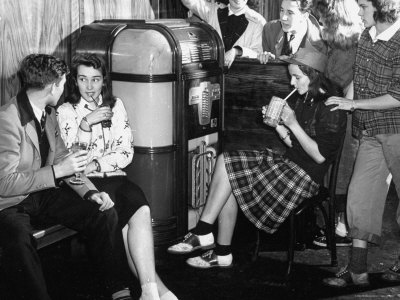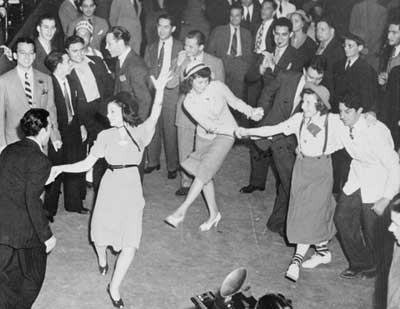A post by Graham Webster
When I was single, I used to go and dance,
Now that I’m married, I cannie get the chance.
Oh, it’s a life, a wearie wearie life,
It’s better to be single than to be a married wife.
(When I Was Single, song c.1930, verse added c.1940)
Whilst the youths had their fun in the dance halls, what was there for children to take part in? It would be true to say that the performance space of schoolchildren lay outside; in the nooks and crannies of unused land, on public stairways and on pavements and roads. Here, the imagination could provide an infinite play space for a number of children – the escapism a relief from the reality of the adult world. Playing with toys was much more of a domestic activity; and is a whole field of study in its own. Firstly, I will consider the folklore of children at this time; the songs, rhymes and games that turned the street into the playground, before looking at toys that children played with.
Records of children’s play from 1940s Scotland, and the wider United Kingdom, are well documented. The first realistic accounts come slightly later, however; in 1951, three teachers from a Leith school decided to make a film, recording the oral and visual testimonies of their pupils.
The Singing Street (available online to watch at Scottish Screen Archive), led by James T.R. Ritchie, gave 23 examples of songs, games, and rhymes that were popular at the time, passed down orally through generations. As Ritchie notes, ‘the favourite themes are love and death.’ This was especially prominent with the coming of war; World War II provided children with songs they had heard in the streets, from newly called up recruits. There was a mixed feeling of cynicism and hope; and the soldiers did not see themselves in a heroic light – as reflected in the verse;
Join up, join up, join up Churchill’s Army
Ten shillings a week, nothing much to eat
Big tackety boots and blisters on your feet.
A game, titled in many sources as Bombers Overhead (with similarities to what we know today as Port and Starboard), transformed the player into a ship, and they reacted to calls of a threatening bomber plane. Whilst stereotypically, the boys games and songs reflect the military actions of Churchill’s army, the girl’s represent life on the home front; most notably considering love and relationships; with a certain amount of divination. Skipping and ring games, for example, predict the future of a selected player:
She is handsome, she is ugly
She is the one from the golden city,
Tell me, tell me, who she loves
For the one and two and three
In The Golden City, the girls then nominate who will be ‘het’, and decide who their boyfriend was. On a greater scale, there is a clear reflection on the youth culture; and the separation between the ‘birds and the bees’. Of course, more innocent games exist, whereby children played as witches, flowers and Cowboys and Indians; or played at chalk-based games, such as peevers and hopscotch. These are difficult to explain in writing! But pop along to our Victory Kitchen Tea Party and you may see such activities in action.
To turn now to toys. There is a wealth of materials available to us in Edinburgh at the Museum of Childhood; however, we must remember that not all families could afford such luxuries in the 1940s, particularly those living in built up urban areas. Again, it may be said that there was a clear gendered division in the interests of boys and girls during the decade. Boys played with Meccano, and other tin, wood and metal toys, such as miniature cars and planes; however during the early years of the war, there was a shortage of such toys as many of the factories instead were asked to produce materials for the war effort. Girls, on the other hand, mainly played with dolls, and replicated domestic items; imitating the world of their mother. The most popular, and cheapest, ‘toy’ for a girl was the paper doll. These gendered divisions in play, although entirely sexist, are still continued in the world today with the likes of the Lego and Barbie franchises. In fact, neutral play came in the outdoors; balls, marbles, hoops, diablos, yoyos and skipping ropes were far cheaper for a parent than indoor toys, and meant that multiple children could play with them at the same time.
The reality of children’s play in the 1940s was simple; children made the most of what they had, imposing their imaginations on their surrounding environments. There was also an element of imitation in play – copying the actions of adults which surrounded them. Join us for our Victory Kitchen Tea Party on Sunday 18th May, between 3-5pm where visitors will get the chance to see more of these activities in action and join in the fun!








